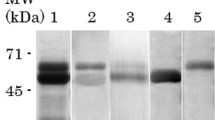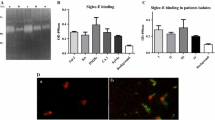Abstract
Parasite-derived trans-sialidase (TS) activity was demonstrated in the serum and blood ofTrypanosoma cruzi-infected mice. Serum TS activity levels correlated well with parasitemia in BALB/c and Swiss mice during the initial stages of the infection. However, in later stages the TS activity levels decreased despite increasing parasitemia. This coincided with the appearance of circulating TS antibodies. On the other hand, there was always a good correlation between TS activity and parasitemia in athymic nude mice. Sera from mice with high parasitemia and low TS activity inhibited TS activity in vitro. The inhibition was also observed with purified serum IgG, and it was absorbed by staphylococcal protein A, indicating that it was caused by anti-TS IgG antibodies. These antibodies inhibited the enzymatic activity of insolubilized TS, indicating that they act by interfering with the catalytic site rather than by aggregating the enzyme. The presence of inhibitory antibodies, however, did not prevent the progression of parasitemia in BALB/c mice.
Similar content being viewed by others
References
Affranchino JL, Ibanez CF, Luquetti AO, Rassi A, Reyes MB, Macina RA, Aslund L, Pettersson U, Frasch ACC (1989) Identification of aTrypanosoma cruzi antigen that is shed during the acute phase of Chagas' disease. Mol Biochem Parasitol 34:221–228
Cazzulo JJ, Frasch ACC (1992) SAPA/trans-sialidase and cruzipain: two antigens fromTrypanosoma cruzi contain immunodominant but enzymatically inactive domains. FASEB J 6:3259–3264
Chaves LB, Briones MRS, Schenkman S (1993) Trans-sialidase fromTrypanosoma cruzi epimastigote is expressed at the stationary phase of growth and is different from the enzyme expressed in trypomastigotes. Mol Biochem Parasitol 61:97–106
Frevert U, Schenkman S, Nussenzweig V (1992) Stage-specific expression and intracellular shedding of the cell surface trans-sialidase ofTrypanosoma cruzi. Infect Immun 60:2349–2360
Hall BF, Webster P, Ma AK, Joiner KA, Andrews NW (1992) Desialylation of lysosomal membrane glycoproteins byTrypanosoma cruzi: a role for the surface neuraminidase in facilitating parasite entry into the host cell cytoplasm. J Exp Med 176:313–325
Hudson L, Hay FC (1980) Practical immunology, Blackwell, Oxford London Edinburgh Boston Melbourne
Laemmli UK (1970) Cleavage of structural proteins during the assembly of the head of bacteriophage T4. Nature 227:680–685
Leguizamon MS, Campetella OE, Gonzalez-Cappa SM, Frasch AC (1994) Mice infected withTrypanosoma cruzi produce antibodies against the enzymatic domain of trans-sialidase that inhibit its activity. Infect Immun 62:3441–3446
Libby P, Alroy J, Pereira ME (1986) A neuraminidase fromTrypanosoma cruzi removes sialic acid from the surface of mammalian myocardial and endothelial cells. J Clin Invest 77:127–135
Medina-Acosta E, Paul S, Tomlinson S, Pontes de Carvalho LC (1994) Combined occurrence of trypanosomal sialidase/trans-sialidase activities and leishmanial metalloproteinase gene homologoues inEndotrypanum sp. Mol Biochem Parasitol 64:273–282
Ming M, Chuenkova M, Ortega-Barria E, Pereira MEA (1993) Mediation ofTrypanosoma cruzi invasion by sialic acid on the host cell and trans-sialidase on the trypanosome. Mol Biochem Parasitol 59:243–252
Parodi AJ, Pollevick GD, Mautner M, Buschiazzo A, Sanchez DO, Frasch AC (1992) Identification of the gene(s) coding for the trans-sialidase ofTrypanosoma cruzi. EMBO J 11:1705–1710
Pereira ME (1983) A developmentally regulated neuraminidase activity inTrypanosoma cruzi. Science 219:1444–1446
Pereira MEA, Mejia JS, Ortega-Barria D, Matzilevich D, Prioli RP (1991) TheTrypanosoma cruzi neuraminidase contains sequences similar to bacterial neuraminidases, YWTD repeats of the low density lipoprotein receptor, and type III modules of fibronectin. J Exp Med 174:179–191
Pereira-Chioccola VL, Schenkman S, Kloetzel JK (1994) Sera from chronic chagasic patients and rodends infected withTrypanosoma cruzi inhibit trans-sialidase by recognizing its amino-terminal and catalytic domain. Infect Immun 62:2973–2978
Pontes de Carvalho LC, Tomlinson S, Vandekerckhove F, Bienen EJ, Clarkson A, Jiang MS, Hart GW, Nussenzweig V (1993) Characterization of a novel trans-sialidase ofTrypanosoma brucei procyclic trypomastigotes and identification of procyclin as a sialic acid acceptor. J Exp Med 177:465–474
Rossi MA, Teixeira ARL, Ribeiro-dos-Santos R (1984) ExperimentalTrypanosoma cruzi cardiomyopathy in BALB/c mice. Am J Pathol 114:209–216
Schenkman S, Jiang MS, Hart GW, Nussenzweig V (1991) A novel cell surface trans-sialidase ofTrypanosoma cruzi generates a stage-specific epitope required for invasion of mammalian cells. Cell 65:1117–1125
Schenkman S, Kurosaki T, Ravetch J, Nussenzweig V (1992a) Evidence for the participation of the Ssp-3 antigen in the invasion of non-phagocytic mammalian cells byTrypanosoma cruzi. J Exp Med 175:1635–1641
Schenkman S, Pontes de Carvalho L, Nussenzweig V (1992b)Trypanosoma cruzi trans-sialidase and neuraminidase activities can be mediated by the same enzymes. J Exp Med 175:567–575
Silva LHP, Nussenzweig V (1953) Sobre uma cepa deTrypanosoma cruzi altamente virulenta para o camundongo branco. Folia Clin Biol 20:191–203
Titto EH de, Araujo FG (1988) Serum neuraminidase activity and hematological alterations in acute human Chagas' disease. Clin Immunol Immunopathol 46:157–161
Uemura H, Schenkman S, Nussenzweig V, Eichinger D (1992) Only some members of a gene family inTrypanosoma cruzi encode proteins which express both trans-sialidase and neuraminidase activities. EMBO J 11:3837–3844
Vandekerckhove F, Schenkman S, Pontes de Carvalho LC, Tomlinson S, Kiso M, Yoshida M, Hasegawa A, Nussenzweig V (1992) Substrate-specificity of theTrypanosoma cruzi trans-sialidase. Glycobiology 2:541–548
Voller A, Bartlett A, Bidwell DE (1976) Enzyme immunoassays with special reference to ELISA techniques. J Clin Pathol 31:507–520
Author information
Authors and Affiliations
Rights and permissions
About this article
Cite this article
Alcântara-Neves, N.M., Pontes-de-Carvalho, L.C. Circulating trans-sialidase activity and trans-sialidase-inhibiting antibodies inTrypanosoma cruzi-infected mice. Parasitol Res 81, 560–564 (1995). https://doi.org/10.1007/BF00932022
Received:
Accepted:
Issue Date:
DOI: https://doi.org/10.1007/BF00932022




